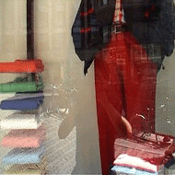 |
|
 |
 |
 |
 |
 |
  |
webwork 3
Life : a User's Manual,
by Michelle TERAN (Canada), 2004
 Urbanites unite in disorientation when, entering a shop, they encounter a TV screen that presents a vision of themselves, while the camera capturing the image is hidden.
Ordinarily, a small locative dance is performed: a step to the left suggests that the camera is in this direction; a tilt of the head reveals that it must be in that corner.
A small, dark-tinted globe or a mechanical-arm recorder is sometimes found, but often not.
Of course, so-called closed circuit television (CCTV) cameras commonly film citizens without announcing their presence; and if you're in the wrong neighbourhood - commercial sectors, largely - a whole outing can go recorded.
But the circuits of these cameras are routinely less closed than their names suggest; most are transmitted on public radio spectra and can be picked up by interested parties with the correct receiver.
Canadian artist Michelle Teran, who visited Montréal recently for the HTMlles, has just such a receiver.
Urbanites unite in disorientation when, entering a shop, they encounter a TV screen that presents a vision of themselves, while the camera capturing the image is hidden.
Ordinarily, a small locative dance is performed: a step to the left suggests that the camera is in this direction; a tilt of the head reveals that it must be in that corner.
A small, dark-tinted globe or a mechanical-arm recorder is sometimes found, but often not.
Of course, so-called closed circuit television (CCTV) cameras commonly film citizens without announcing their presence; and if you're in the wrong neighbourhood - commercial sectors, largely - a whole outing can go recorded.
But the circuits of these cameras are routinely less closed than their names suggest; most are transmitted on public radio spectra and can be picked up by interested parties with the correct receiver.
Canadian artist Michelle Teran, who visited Montréal recently for the HTMlles, has just such a receiver.
Teran's Life: A User's Manual takes both its name and its mandate from Oulipo.
Her titular appropriation is the English translation of Oulipo-member Georges Perec's La Vie mode d'emploi (1978), while the borrowed ambition is the inevitably doomed attempt at instituting order onto a seemingly chaotic mass of information.
With Oulipo, this mass is language; with Teran, it is the city - the Netherlands' Utrecht, in particular.
In 2002-03 Teran took a series of ten public walks in Utrecht, accompanied by her 2.4 GHz receiver, a television connected to same, video cameras, and a few interested individuals.
When her receiver picked up a transmission, she attempted to discern the image (the broadcast was frequently fuzzy) or establish where the camera was located; if this was apparent, Teran would inform the proprietor of her signal-piracy. From this brilliant premise, Teran has haphazardly mapped the walks online and included video excerpts from the intercepted transmissions, not to mention written snippets of dialogue between herself, her procession of fellow walkers, and the camera-owners.
Teran's findings range from the revelatory to the mundane. Most surprisingly, the shopkeepers she converses with show an incredibly nonchalant attitude in discovering that an itinerant artist is pirating their signal; one would expect anger and cop-calls, so the kindness may speak to Utrecht more than anything else. The subjects videoed are occasionally startling - an overhead shot of a roulette wheel, a distinctly voyeuristic view of a women's shoe store - but more frequently they display the sheer banality of what people choose to have a sense of propriety over; that is to say, doorways, doorways, doorways. Doorways to the most unthreatened places are recorded: cheese shops, tennis courts, and, with obsessive return, nowhere…
With this prosaic palette of CCTV camera feeds, Teran charts a celebration of the commonplace and muses all the while about her role in the undertaking - is she a pervert or a pirate, a "sister of Big Brother" (as one of her cohorts puts it) or a more subversive relative?
In the main, Life's position is undecided, its findings inconclusive; then again, such is Life.
Patrick Ellis

 top top
 back back
|
|
 |
 |
 |
|
